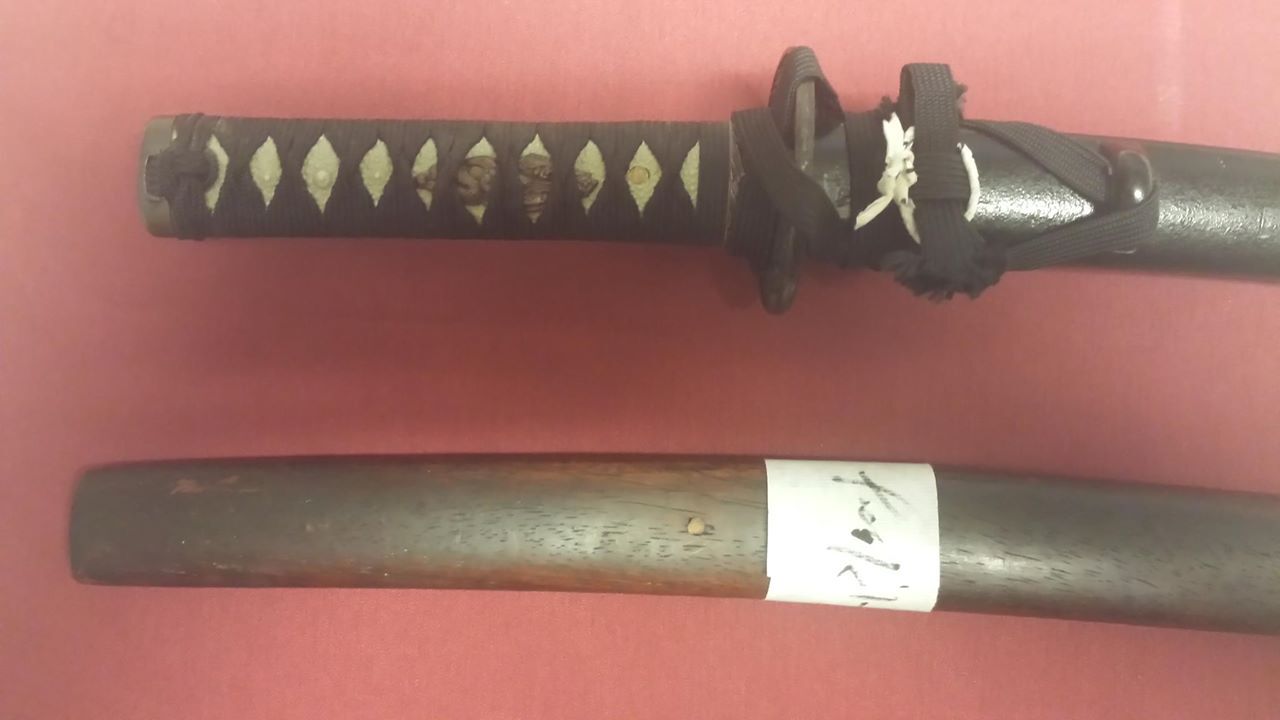
A reproduction of how the two Japanese swords were kept in the “tokonoma = 床の間 (alcove)” in the room.
Iwama is the place where late Morihei Ueshiba, the Founder of Aikido, had spent his late years. His house had been built next to the Dojo which was right next to the Aiki Shrine on its property. And in the “tokonoma = 床の間 (alcove)” of one of the rooms of his newly built house, there were always a scroll of a portrait of the Founder of Aikido as a good luck charm for the house hung on a wall of the room and “OMITACHI (御神太刀)” and “KATANA (刀)” on a sword rack.
The photo is a reproduction of how the two Japanese swords were kept in the “tokonoma = 床の間 (alcove)” in the room. The OMITACHI (御神太刀) without its “tsuba (鍔 = a hand guard)” was far wider and longer than the one in the photo, and it was dedicated for use for Shinto-related rituals, rather than to be worn or carried around.
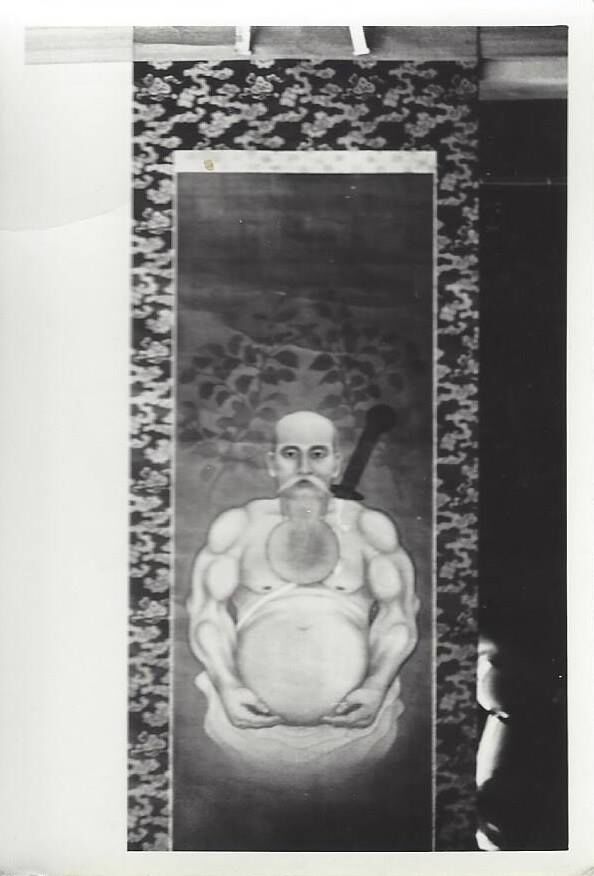
掛け軸 (Kakejiku) = A Hanging Scroll
The photo was taken during a photo shoot by a publishing company when the Kakejiku was removed from the Tokonoma (alcove) where it used to be ke. The item(s) in the photo is/are owned by Nippon Kan Archive
What I want all readers to pay a particular attention to is the fact both swords are sealed by a strip of “washi” papers. Of course, both swords could be easily pulled out of the sheaths with ease; however, the fact still remains that it would have been obvious and apparent if the “washi paper seal” had been broken. Besides, how a strip of “washi” paper should be tied to seal a sword had been a family secret that no one could replicate how it was done. Moreover, the room was also the bedroom for the Founder of Aikido, and hence the room was off-limits, except for a very small group of people, i.e. Ms. Kikuno, who was a live-in housemaid to the Ueshiba family, late Mr. & Mrs. Morihiro Saito and myself. By the way, I had learned this particular way to knot to seal a sword from Mrs. Hatsu Ueshiba. In short, the swords had been sealed and were never to be used to cause any harm.
I truly believe that the seal of the swords is an immovable evidence to validate and support the Founder’s Aikido Philosophy in his late years.
Anything with a blade, including Japanese swords, can be used for combat purposes to injure or kill living matters, including humans. Yet, things with a blade can also be very useful to yield many products to enrich our lives, from food preparation to cutting woods to make a sculpture, among countless other productive uses of a variety of bladed objects.
The greatest achievement of the Founder of Aikido, in my belief, is to have invented a Budo called Aikido that many people can practice today that is not competitive and that transcends our races, ethnic backgrounds, religions or ideologies. And he had done so by sealing the use of swords, whose primary purpose had been to combat, injure and/or kill enemies, while extracting the movements of using a Japanese sword to create a system of “Taijutsu = 体術”, which collectively is known and widely practiced as Aikido. And for this great achievement, a good number of Aikido practitioners admire the Founder of Aikido as if he is a god, whereas he was not a god but a human being like ourselves.
Lately, there seems to be an increasing number of Aikido instructors and Aikido practitioners to practice what they call “weapons training” whose movements are not at all aligned with the movements of empty-hand techniques. Because those moves do not seem to be related to the empty-hand techniques of Aikido, they must not be the proper movements of bokken techniques in Aikido. Even worse, I have seen the use of a fake sword with a metal blade, that could be used to injure and/or kill a human, in the name of training. It was obvious that the movements of such utterly non-traditional practices were of a dark sword with intent to injure or kill an enemy, and many practitioners of such utterly improper “weapons training” seem elated and drunken by their own sword movements in self-induced euphoria. It is as if chasing and drowning oneself in the world of movies, cartoons and computer games.
Moreover, most of these so-called weapons training practitioners are very rough, crude and usually improper in their handling of their weapons. Nevertheless, they seem to have a quite high level of respect toward their weapons as if dignifying them beyond their worth, thereby trying to maintain a certain level of dignity in themselves…
After all, all of them seem to be elated by their own sword movements while none of them seems to realize or understand at all the consequences of undisciplined use of a sword. Some of such practitioners have displayed ecstatic expressions after having done practice moves so well that they could feel so sure of themselves to have cut through the opponent if it were a real situation.
When sliced by a sword, one’s internal organs would overflow in an instant; when cut on the neck or on the arm, one’s head or arm would hang by the skin if not fall to the ground… They would be showered with the blood of their enemies, and they may not be able to open their eyes because of the sticky blood on their eyelids… Aikidoists, who cannot imagine such hellish, horrific consequences from using a sword but pursues to get exhilarated by their own undisciplined sword movements, should never call Aikido a Budo of peace and harmony.
By the way, I have no issue against anyone if the person is practicing sword movements in their practice of Iaidō (居合道), in between and in addition to their practice in Aikido, since they are totally different Budo from each other.
The essence of the Founder of Aikido’s Kenjutsu (剣術) (a general term for all schools of Japanese swordsmanship) is “Minimum damage for Maximum effect”. If you study carefully demonstration “Enbu (演武)” by the Founder of Aikido, his moves are to cut slightly wrists, an area under an armpit or the side of a knee. After all, deterring effectively the opponent serves the purpose sufficiently. Inflicting needless or excessive casualties is out of the question.
I recall it was quite rare, if not almost none at all, for the Founder of Aikido to teach a weapons class at Hombu Dojo in his late years, and there were only a few bokkens at Hombu Dojo, placed rather disorderily along the edges of the dojo floor in those days. In other words, none of then-Shihan or then-instructors (some of whom are Shihan presently) have not been taught any weapons techniques by the Founder of Aikido. What are commonly known & practiced today as weapons techniques are what he had accomplished in his late years at the Iwama Dojo adjacent to Iwama Aiki Shrine.
And it was late Morihiro Saito Shihan, 8th dan in Aikido (1928 – 2002), who had served to the Founder of Aikido the longest in history as a life-time student, while having his residence right next to the residence of the Founder of Aikido and his family, with his life-long dedication & commitment to the Founder of Aikido and to the art & budo of Aikido, who structured the Founder’s weapons techniques as a system of Jo and Bokken movements.
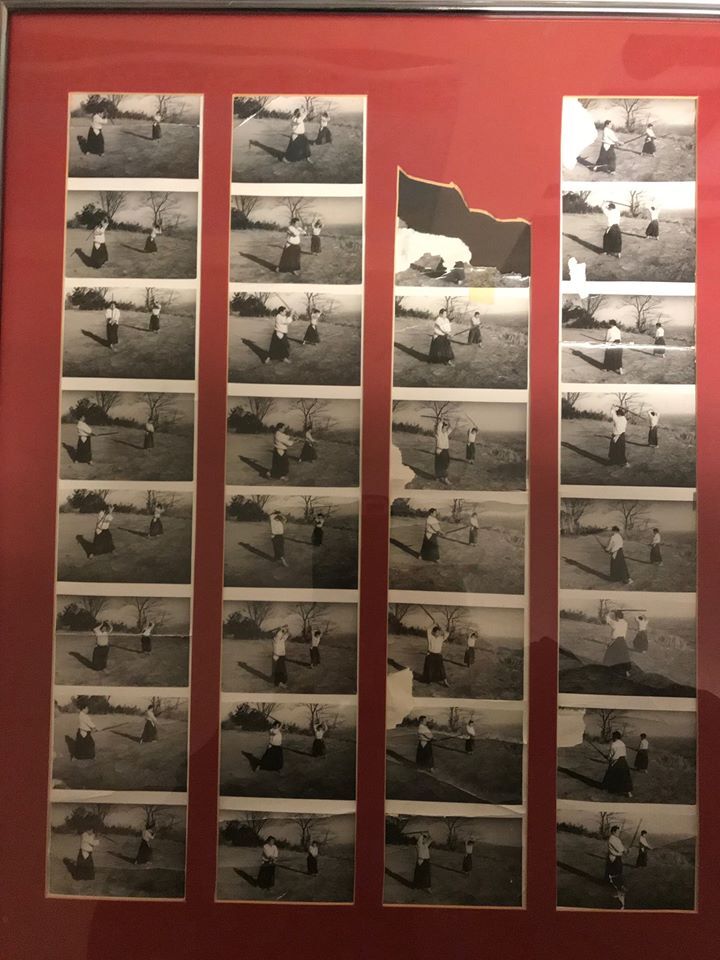
A roll of negatives from the photo shoots before late Morihiro Saito Shihan published 5 volumes technical books on bokken & Jo techniques. The negatives are a part of the collection of items that was bestowed on me by late Saito Shihan before I departed for my hometown after the demise of the Founder of Aikido. The item(s) in the photo is/are owned by Nippon Kan Archive
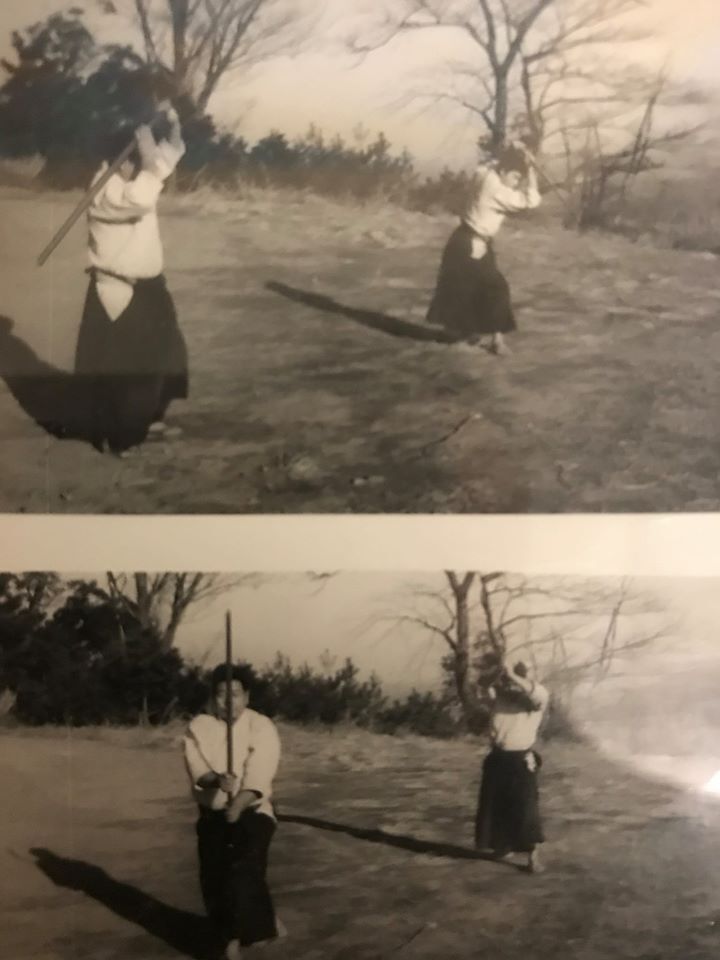
The item(s) in the photo is/are owned by Nippon Kan Archive
A countless number of uchideshi had trained under late Morihiro Saito Shihan, and a good number of them went back to their hometowns and countries to start teaching what they had learnt under late Morihiro Saito Shihan at the Iwama Dojo. In the U.S., a former uchideshi in California was the first to start teaching Jo & Bokken techniques, and it spread at an astonishing velocity throughout the U.S.
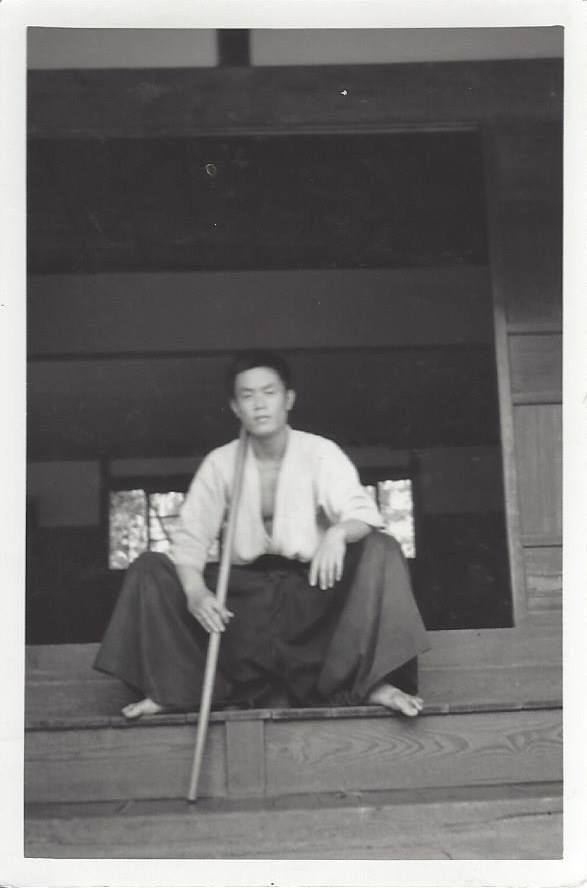
The author, Gaku Homma when he was about 16 ~ 17 years old at the Iwama Dojo. The item(s) in the photo is/are owned by Nippon Kan Archive
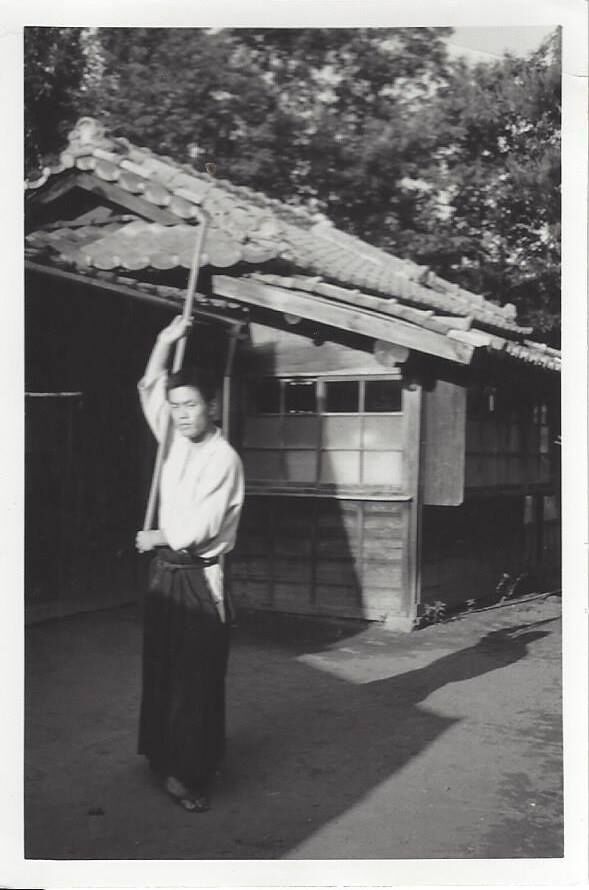
The author, Gaku Homma when he was about 16 ~ 17 years old at the Iwama Dojo. The item(s) in the photo is/are owned by Nippon Kan Archive
According to notifications by Aikikai Hombu Dojo, Aikikai Hombu Dojo does not officially approve of instructing or of practicing Jo or Bokken techniques. However, it is a reality that many Aikikai-affiliated dojo throughout the world have been practicing Jo and Bokken disciplines as part of their practice routines. It’s very sad and unfortunate that the path of the systematic structure of Jo & Bokken movements in Aikido complied by late Saito Shihan given his decades of practice directly under the Founder of Aikido seems to have disorderily veered off course to the left field, partly due to the lack of proper leadership control and instructional guidance by Aikikai Hombu Dojo. What is even worse and quite lamenting is that some Aikidoists seem to have created their own style of quite low-quality weapons movements, and this is like a degrading quality of a print when the 1st copy is copied and the 2nd copy is copied, and so on…
Those Aikidoists who seem to get elated in euphoria by swinging swords that resemble fake ones often seen in movies and cartoons can be described to have created a totally new & different way of Budo in which practitioners are seemingly supposed to practice confronting an enemy with a sword with harmful intent and to get a sense of satisfaction from putting their sword (i.e. a weapon) back into its sheath, while seemingly still in self-induced euphoria. It is my firm opinion that such conduct by anyone is utterly and totally against the very Aikido the Founder of Aikido founded as a Budo of the world to be practiced by and with any people in the world around the globe.
It’s important for all Aikidoists, instructors and students alike, to be ingenious in our endeavor in the practice of Aikido. At the same time, it’s as imperative to remain true to the tradition and the style of instructions that are backed by the hard work and dedications by our predecessors whom we respect and admire. Aikikai Hombu Dojo should perhaps clarify “why weapons training is not encouraged by Aikikai Hombu Dojo” instead of criticizing late Morihiro Saito Shihan.
Much practice hours are allocated for keiko in Jo & Bokken techniques in Nippon Kan Aikido at Nippon Kan. Regular practice in Jo & Bokken techniques is not only for enhancing our resilience & strength in our mind, spirit and muscle powers and reflex actions in executing empty-hand body techniques, but for our better understanding of the origins of Aikido’s empty-hand body techniques. It’s not at all by any means to harm any opponent. In fact, any Aikido instructor who teaches sword movements should face a 4th dan or a 5th dan holder in Kendo (剣道). It should be instantaneous for a Kendo practitioner to defeat an Aikido practitioner in a face-off. And it would be an eye-opening aha! moment for an Aikidoist to realize the purpose of Jo & Bokken practices in Aikido.
After all, the use of a sword in Aikido is not for injuring or killing humans(殺人剣, pronounced “satsujinken” ). The use of a sword in Aikido is for purging iniquity, immorality, indecisiveness or straying minds, etc. out of us. All of us must think deeply about why the Founder of Aikido had reached the state of mind to seal the swords. All of us must realize how important it is to sheath a sword and keep it sheathed while wishing for peace and to work toward peace more than anyone else by putting our money where our month is as Aikidoists. This is the purpose of practice among our fellow Aikidoists at Nippon Kan.
Lately, the world seems to have become more divisive while the globe seems to have become smaller & smaller with the ever-increasing proliferation of internet connectivity and the use of mobile devices. In times like this, it might be important to reflect upon ourselves first rather pointing the finger at others in knee-jerk reactionary manners.
After all, only Budo practitioners who know in their heart that only tragedies would follow even if they must draw a sword out of its sheath are the real ones.
I firmly believe that the Founder of Aikido had reached the revelation after decades of long & arduous Shugyo(修行) to seal the swords with a mantra of “Not to fight; Not to confront” as his guiding light in the era after the WWII in Japan. Then, he had further progressed to leave behind the swords to evolve the art & budo of Aikido that is centered around the practice of “Taijutsu (体術)”.
Because far too many instructors are seen to mimic irrational, absurd movements that seem to be out stunt scenes from movies and cartoons, I have decided to express my feelings and opinions with a wish for us to continue keeping our perspective straight & nurturing mind sharper to discern what are fake and not to be deterred by fake stuff to firmly remain on a proper path of Shugyo.
Last but not least, I would like to share a short Zen story:
“On a day of blizzard, a traveler found a Zen temple and was allowed to stay until the blizzard passed.
As the blizzard went on, the supply of firewood was getting low, and the traveler noticed a Zen master had brought a big wooden statue of Buddha and was about to turn it into firewood. The traveler jumped up in astonishment and exclaimed, “Please don’t! It’s precious Buddha, of all the matters!
Then the Zen master said, “Not to worry; it’s all right. I just will have to carve it out of wood again. Even if I chop this one and burn it, I can always make another one so long as I maintain the spirit of Buddha in me.”
Bokken and Jo are both made of wood. How we use them to is all up to us.
“A Budo does not make people; People maketh the Budo.” It’s all up to us to achieve Peace.
With much and sincere wish that all of us can and will continue to endeavor in the practice of Aikido in the year 2018 with good health in our bodies and peacefulness in our minds.
AHAN Nippon Kan
Founder & Kancho – Gaku Homma
Written on January 4, 2018
Note: About the words “Bokken” and “Sword(s) (i.e. 真剣, literally meaning “real sword”)”
Bokken (木剣, literally “wooden sword”) are used in the practice of Aikido as a replacement of Shinken (真剣, literally “real sword”) with the same respect and attitude required for using a Shinken (真剣, literally “real sword”). Therefore, both words are often used interchangeably.
Note: Ownership of copyright belongs to the author, Mr. Gaku Homma.

